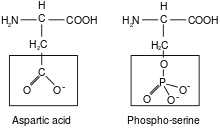Phosphomimetics
Phosphomimetics are amino acid substitutions that mimic a phosphorylated protein, thereby activating (or deactivating) the protein. Within cells, proteins are commonly modified at serine, tyrosine and threonine amino acids by adding a phosphate group. Phosphorylation is a common mode of activating or deactivating a protein as a form of regulation. However some non-phosphorylated amino acids appear chemically similar to phosphorylated amino acids. Therefore, by replacing an amino acid, the protein may maintain a higher level of activity. For example, aspartic acid is chemically similar to phospho-serine. Therefore, when an aspartic acid replaces a serine, it is a phosphomimetic of phospho-serine and can make the protein always in its phosphorylated form.

Applications
This chemical similarity can be exploited in cancer, where a protein may mutate into an "always on" (constitutively active) state. A mutation may occur to replace a tyrosine (which needs to be phosphorylated in order to activate the protein) with an aspartic acid (which would not need to be phosphorylated). In a laboratory setting, the use of recombinant proteins to artificially introduce phosphomimetics is a common tool for studying phosphorylation and protein activation. For example, the IRF3 protein must be phosphorylated for its normal activity (transcription of its target genes, like IFNβ), but when serine amino acid residues were mutated to aspartic acid, the activity increased 90-fold.[1] Phosphomimetics are commonly used in a gain of function experiment with respect to phosphorylation. For example, aspartate mutants were successfully used to probe the biological function of the phosphorylation of a threonine residue of a ribosomal protein both in vivo[2] and in vitro[3] as part of a gain of function studies of a mutation on a kinase that is related to Parkinson's disease. Phosphomimetics were also used to investigate the therapeutic potential of proteins or peptides. For example, phosphomimetic mutants (using glutamate to mimic serine phosphorylation) have been used to demonstrate that the phosphorylated glycoprotein may have stronger anti-melanoma effects that the wildtype protein.[4] This approach is in particularly useful as up to three serine residues can be phosphoylated on the said protein,[4] and hence phosphomimetic mutants are useful to probe the function of the individual phosphorylation.
References
- Hiscott J, Pitha P, Genin P, Nguyen H, Heylbroeck C, Mamane Y, Algarte M, Lin R (Jan 1999). "Triggering the interferon response: the role of IRF-3 transcription factor". J Interferon Cytokine Res. 19 (1): 1–13. doi:10.1089/107999099314360. PMID 10048763.
- Ian Martin, Jungwoo Wren Kim, Byoung Dae Lee, Ho Chul Kang, Jin-Chong Xu, Hao Jia, Jeannette Stankowski, Min-Sik Kim, Jun Zhong, Manoj Kumar, Shaida A Andrabi, Yulan Xiong, Dennis W Dickson, Zbigniew K Wszolek, Akhilesh Pandey, Ted M Dawson, Valina L Dawson (2014). "Ribosomal protein s15 phosphorylation mediates LRRK2 neurodegeneration in Parkinson's disease". Cell. 157 (2): 472–485. doi:10.1016/j.cell.2014.01.064. PMID 24725412.CS1 maint: uses authors parameter (link)
- Danilo Correddu, Nabangshu Sharma, Simranjeet Kaur, Kyriakos G Varnava, Naasson M Mbenza, Vijayalekshmi Sarojini, Ivanhoe K H Leung (2020). "An investigation into the effect of ribosomal protein S15 phosphorylation on its intermolecular interactions by using phosphomimetic mutant". Chem. Commun. 56 (57): 7857–7860. doi:10.1039/d0cc01618g. PMID 32583822.CS1 maint: uses authors parameter (link)
- Ye Feng, Wenjing Bao, Yanli Luo, Ling Tian, Xiafang Chen, Miaoying Yi, Hui Xiong, Qian Huang (2012). "Phosphomimetic mutants of pigment epithelium-derived factor with enhanced anti-choroidal melanoma cell activity in vitro and in vivo". Invest. Ophthalmol. Vis. Sci. 53 (11): 6793–6802. doi:10.1167/iovs.12-10326. PMID 22952124.CS1 maint: uses authors parameter (link)